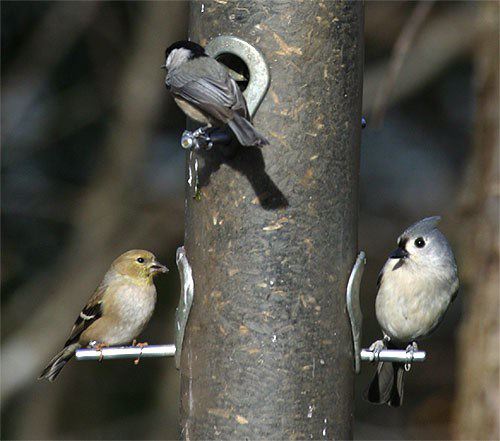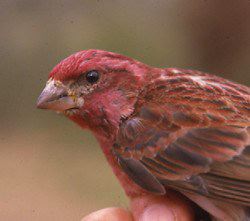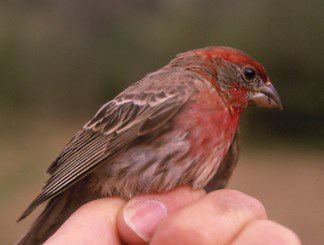 HOME: www.hiltonpond.org |
|||
|
THIS WEEK at HILTON POND (Back to Preceding Week; on to Next Week) |
|
PROS AND CONS OF The world of ornithology--of which Hilton Pond Center is a tiny part--has been all a twitter in the past week about a 27 December 2002 article in the Wall Street Journal. Its two-stage headline states "Feeding Wild Birds May Harm Them and Environment: Feeding Wild Birds Lures Pests, Predators, Causing Illness and Distorting Populations." The front-page article, written by James P. Sterba, has been taken to task by everyone from hummingbird banders to the director of the Cornell Laboratory of Ornithology. 
American Goldfinch, Carolina Chickadee, and Eastern Tufted Titmouse aboard a sunflower seed feeder at Hilton Pond Center, 7 Jan 2003. All three birds are banded and seem not to have been harmed by the feeder.
Sterba's rather inflammatory approach was misleading and, for the most part, based on misinterpretation of observable facts. Folks tend to believe what they read in the Wall Street Journal, and some busy professionals may use it as their sole source of information about various topics. If at all, Sterba's article should have appeared on the editorial page with a disclaimer that it was an opinion piece--not a news item.  Unfortunately, Sterba created the effect he apparently desired; there are reports that many Journal subscribers have been frightened into taking down their bird feeders--aghast at the sudden knowledge they might have been killing backyard avifauna all these years. Unfortunately, Sterba created the effect he apparently desired; there are reports that many Journal subscribers have been frightened into taking down their bird feeders--aghast at the sudden knowledge they might have been killing backyard avifauna all these years.
Rather that dissect every point made by Sterba, we'd like to concentrate on one seminal paragraph: "Most people think all that largess helps the birds. But many ornithologists and wildlife biologists say it does very little good--and even does some harm. Attracting wild birds to feeders spreads disease, aids predators such as house cats, and lures the birds close to houses and roads where tens of millions of them fly into windows and cars. House cats and hawks treat feeders as fast-food outlets, snatching birds from perches or the ground below." So what's wrong with Sterba's article, and his logic? A lot, we think. --For one, Sterba doesn't cite scientifically rigorous studies that conclusively show that feeders harm backyard birds; his contention that "many ornithologists and wildlife biologists" are neutral or negative about feeders is not substantiated. Elsewhere in his article he quotes some unusual sources who appear not to have published their conclusions in refereed scientific journals, so their work may be viewed with some skepticism. --Feeders probably do help spread bird diseases, but only among those birds that naturally flock together. For example, American Goldfinches and Purple Finches (adult male, below right) often occur in large numbers at feeders, but in the absence of artificial feeding they still would congregate at natural food sources and transmit diseases among one another. These displaced House Finches (adult male, below left)--which are native to the western U.S.--did quite well for themselves, extending their breeding range about 25 miles each year until they nested in every state east of the Rockies. --Condemning bird enthusiasts for cat-kills at feeders is putting blame in the wrong place. Sterba should have chastised cat owners who let their pets roam freely. Personally, we think cats are amazing creatures, but they have absolutely no business being outside where they can kill native wildlife; there is, after all, a reason why they are called "house cats" and not "yard cats." Cats are highly efficient, and killing birds is something they do very well--even when they're not hungry. If cats are taking birds at feeders, keep the cats indoors; if they're feral cats, trap and euthanize them lest they kill small animals and spread diseases of their own. It's unfortunate that "cats vs. birds" is such an emotionally charged issue; we could save a lot of wildlife in this country if all cat owners took time to objectively study just how much carnage is caused by free-roaming felines.
--Sterba is correct in saying that feeder birds, startled by humans or cats or hawks, do occasionally crash into patio doors and windows, and some die from the encounter. (Some birds also are hit by vehicles, as Sterba says, but we don't see that feeders are the cause of this.) To birds, a window looks like a hole in a wall through which they should be able to fly, so it's up to bird enthusiasts to minimize window strikes by hanging drapes or by moving the feeder so that some other escape route is more obvious to birds in transit. By the way, far more birds fly into feeder-less commercial structures and TV towers than into residential windows; if only businesses would quit lighting their tall buildings during the birds' spring and fall migration periods . . . . There may be a grain of truth to some of Sterba's anti-feeder arguments, but we can minimize the negatives with a little thought and regular maintenance. A filthy, poorly maintained feeder probably does serve as a repository for avian diseases, so it's the birdwatcher's job to keep the feeder clean; after all, you wouldn't let the food in your dog's bowl get moldy, so the same should go for your bird feeders. We know of no scientifically rigorous studies that have shown that feeding birds is bad for them, but there's also no conclusive evidence that it's particularly good for them, either. Some birds have extended their ranges in recent times, but it's hard to prove that feeders were the actual cause. In the long run, it may be that feeding birds is a neutral activity that has no real impact--pro or con--on wild bird populations. Our gut feeling, however, is that providing feeders will become increasingly beneficial--even necessary--for some bird species, especially as we continue to destroy natural habitats in which birds historically found food and shelter. Feeding birds is an educational, rewarding pastime for millions of people who, as a result, often become much more aware of the natural world around them. Here at Hilton Pond Center, we intend to take Mr. Sterba's anti-feeder commentary with a grain of salt and will continue providing seeds for songbirds and sugar water for hummingbirds. Unless Sterba can come up with real proof for his suppositions, we hope you'll do likewise and learn all you can from the feathered creatures that frequent your plentiful--and properly maintained--backyard bird feeders. Some other responses to Sterba's article NOTE: Be sure to scroll down for an account of all birds banded or recaptured during the week, as well as some other interesting nature notes. "This Week at Hilton Pond" is written and photographed by Bill Hilton Jr., executive director of Hilton Pond Center for Piedmont Natural History. You may wish to consult our Index of all nature topics covered since February 2000. You can also use the on-line Search Engine at the bottom of this page. For a free, non-fattening, on-line subscription to "This Week at Hilton Pond," just send us an E-mail with Subscribe in the subject line. Please be sure to configure your spam filter to accept E-mails from hiltonpond.org. |
|
Make direct donations on-line through
Network for Good: |
|
|
LIKE TO SHOP ON-LINE?
Donate a portion of your purchase price from 500+ top on-line stores via iGive: |
|
|
Use your PayPal account
to make direct donations: |
|
 Curiously, populations of these two species seem to be doing quite well, in spite of bird feeders. Sterba mentions elsewhere in his article that populations of House Finches, another common feeder bird, have declined by 60% in the past decade in the eastern U.S., apparently because of conjunctivitis --a highly contagious eye disease. In this case he demonstrates his woeful ignorance of ornithology by not recognizing that prior to 1940 there were NO House Finches in the eastern U.S.; all the birds that occur here now are descendants of small flocks that were released in New York in 1940 and 1941.
Curiously, populations of these two species seem to be doing quite well, in spite of bird feeders. Sterba mentions elsewhere in his article that populations of House Finches, another common feeder bird, have declined by 60% in the past decade in the eastern U.S., apparently because of conjunctivitis --a highly contagious eye disease. In this case he demonstrates his woeful ignorance of ornithology by not recognizing that prior to 1940 there were NO House Finches in the eastern U.S.; all the birds that occur here now are descendants of small flocks that were released in New York in 1940 and 1941. This skyrocketing population--initially inbred--was a ticking time bomb waiting for some disease that would bring an inevitable crash in numbers; mycoplasmal conjunctivitis apparently was that disease, so now the size of the eastern House Finch population is probably stabilized--and more healthy overall. (See our paper on
This skyrocketing population--initially inbred--was a ticking time bomb waiting for some disease that would bring an inevitable crash in numbers; mycoplasmal conjunctivitis apparently was that disease, so now the size of the eastern House Finch population is probably stabilized--and more healthy overall. (See our paper on  --Sterba's complaint that feeders are bad because they attract songbirds that, in turn, attract hawks is bogus. Sharp-shinned Hawks (juvenile female, right) and Cooper's Hawks--the accipiter hawks--are predators of all birds smaller than they are. A successful hawk may indeed hang out where there are lots of birds, e.g., a feeder, but on various occasions we've seen sharpies bust into flocks of American Robins and Common Grackles-- species that congregate AWAY from backyard bird feeders. Sometimes a Sharp-shinned Hawk will terrorize a feeder, knocking off an occasional goldfinch or Northern Cardinal, but--unlike house cats--sharpies are NATIVE predators and they don't kill for sport.
--Sterba's complaint that feeders are bad because they attract songbirds that, in turn, attract hawks is bogus. Sharp-shinned Hawks (juvenile female, right) and Cooper's Hawks--the accipiter hawks--are predators of all birds smaller than they are. A successful hawk may indeed hang out where there are lots of birds, e.g., a feeder, but on various occasions we've seen sharpies bust into flocks of American Robins and Common Grackles-- species that congregate AWAY from backyard bird feeders. Sometimes a Sharp-shinned Hawk will terrorize a feeder, knocking off an occasional goldfinch or Northern Cardinal, but--unlike house cats--sharpies are NATIVE predators and they don't kill for sport. It's also a good idea to decorate your yard with plenty of evergreen trees and brushpiles into which birds can escape from predators instead of flying "through" your bay window. Installing other plants that bear fruit or provide nesting material is also a desirable activity for every bird-loving landowner.
It's also a good idea to decorate your yard with plenty of evergreen trees and brushpiles into which birds can escape from predators instead of flying "through" your bay window. Installing other plants that bear fruit or provide nesting material is also a desirable activity for every bird-loving landowner.

 You can also
You can also